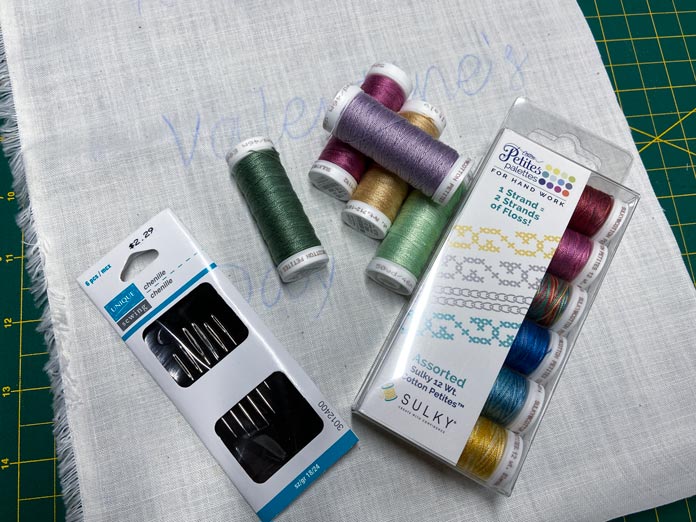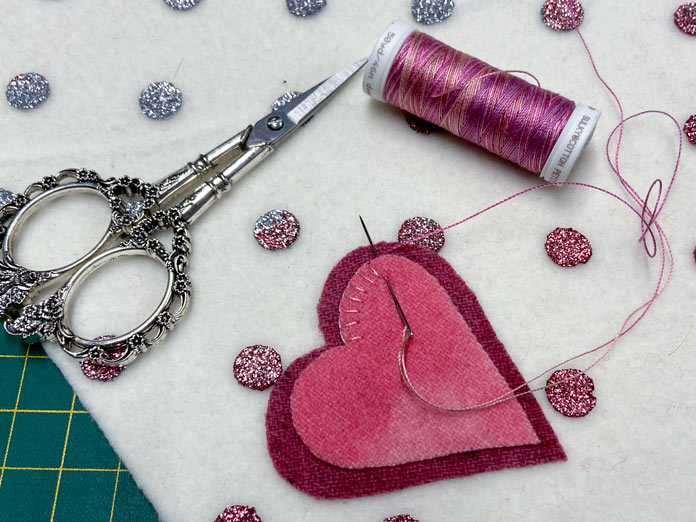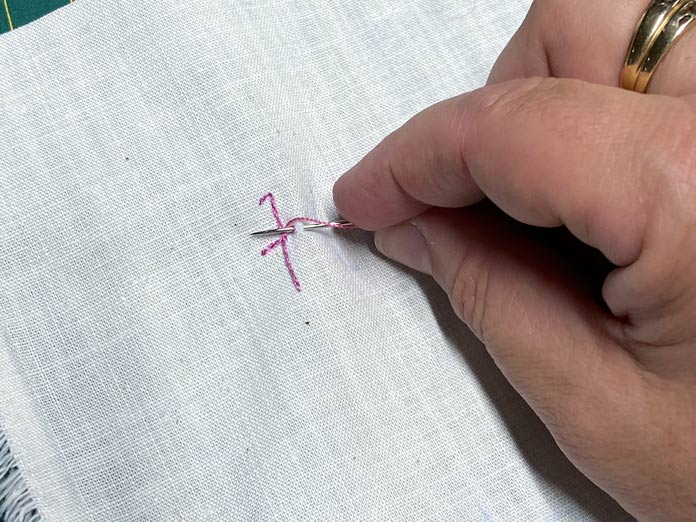Yesterday on QUILTsocial I demonstrated how to transfer embroidery designs to fabric the easy way using DMC Embroidery Transfer Paper. We also traced our heart-shaped templates onto the paper backing of HeatnBond EZ Print Feather Lite iron-on adhesive. Today, I’ll guide you through the remaining steps of easy wool applique and then start stitching, using a variety of Sulky Cotton Petites 12 Wt. thread. I have two sets of threads – one is the Rosewood Manor Assortment, featuring 6 soft solid colors, and the other is the Most Pop Blendables Assortment, a collection of beautiful variegated threads.

A collection of Sulky Cotton Petites 12 Wt. thread
Today, I’m headed to my quilting group, a monthly gathering at a local community center. We all work on our projects or simply engage in conversation. I plan to continue working on my Valentine’s banner, so I’ve packed up all my supplies in the Hemline Gold Multi-Use Craft Bag. This bag offers ample space and features a fold-down flap with a quilted ironing mat for quick pressing. The large internal pocket accommodates a small cutting mat. With strong and durable handles that comfortably fit over the shoulder and numerous pockets for tools and notions, it’s a convenient choice. The bag’s 100% cotton outer shell showcases the signature Hemline Gold Print, and after taking it to a retreat last month, it garnered much attention.

Hemline Gold Multiuse Craft Bag all packed and ready to travel.
To complete wool applique with fusible web, you can follow these 7 steps.
Step 1 Trace your applique shapes on the fusible web.
Yesterday, I traced my applique shapes on the paper side of the HeatnBond EZ Print Feather Lite iron-on adhesive. When working with fusible web, be sure to trace each shape according to the pattern’s indicated quantity. In my case, for the banner project, I traced 2 of each heart shape.
Step 2 Cut the shapes apart.
Next, cut the traced shapes apart, leaving a small amount of fusible web on all sides of each shape. If you’re using the same color of wool for multiple shapes, there’s no need to cut those apart.
Step 3 Iron to the wool.
Next, iron the traced shapes to the back of your chosen wools. I’m ironing one small and one large shape onto each of two pink wools. Follow the manufacturer’s instructions: preheat the iron to medium heat, no steam, and iron for only 2-3 seconds. I’m using my OLISO M2Pro Mini Project Iron which fits perfectly on the Hemline Gold Multi-Use Craft Bag’s quilted ironing mat.

Iron the applique shapes to the back of the chosen wool.
Step 4 Cut along the drawn shapes.
Using sharp scissors cut the applique shapes along the drawn lines. Since the wool has been felted the shapes will not fray.

Cut along the drawn lines.
Step 5 Peel off the paper backing.
Now, peel the paper backing off each shape, revealing a thin film of adhesive on the back of the wool.

Peel off the paper backing.
Step 6 Place the cut-out shapes on your background fabric and fuse them in place.
After cutting out the shapes, arrange them on your chosen background fabric. Wool applique shapes work well on various fabrics, with wool and cotton being my preferred options. When fusing them in place, I’ve found that using a bit of steam helps HeatnBond Feather Lite adhere securely to the background fabric. To protect the wool from burning, insert an old damp tea towel between the wool and the iron. Hold the iron in place for 5-10 seconds.

Fuse wool applique shapes in place with a damp tea towel under the iron.
Step 7 Stitch in place.
As mentioned earlier, felted wool doesn’t fray, so technically, stitching around each shape isn’t necessary. However, I prefer the aesthetic, and most patterns recommend stitching around wool applique shapes. For this outlining, I typically use a blanket stitch. The variegated Sulky Cotton Petites 12 Wt. thread adds a beautiful touch to the wool fabric. When doing wool applique, I always use chenille needles. The UNIQUE Sewing Chenille Needles – sizes 18/24 work well for hand sewing with this thread weight, and the assorted sizes in the pack ensure you have the right needle for your stitching. The KLASSÉ 4½″ Embroidery Scissors which come included in a set with a tape measure, are not only sharp but also conveniently sized for your hand-stitching bag.

A blanket stitch is used to outline each of the wool shapes.
I’ll use these needles and threads to embroider the words on my banner. While various stitches can be used for this, I’ve opted for a stem stitch for my sample. A chain stitch would have also been a suitable choice.

Use a stem stitch to embroider the words on the fabric.
Here is a link to a video that shows some basic embroidery stitches, including the blanket stitch, stem stitch and chain stitch:
https://youtu.be/2EQ3ThLX8FQ?si=ntiqTJLtYmQCB_-j
With the help of DMC Embroidery Transfer Paper, HeatnBond EZ Print Feather Lite iron-on adhesive and Sulky Cotton Petites 12 Wt. thread, my Valentine’s Day banner is coming together. In the next blog post, I’ll assemble all the components, add embellishments with buttons, and I’ll guide you through making the wool part of the banner removable using hook and loop tape.
This is part 4 of 5 in this series
Go back to part 3: How to transfer designs to fabric | DMC Embroidery Transfer Paper
Go to part 5: An easy way to make an embroidered wall banner interchangeable
